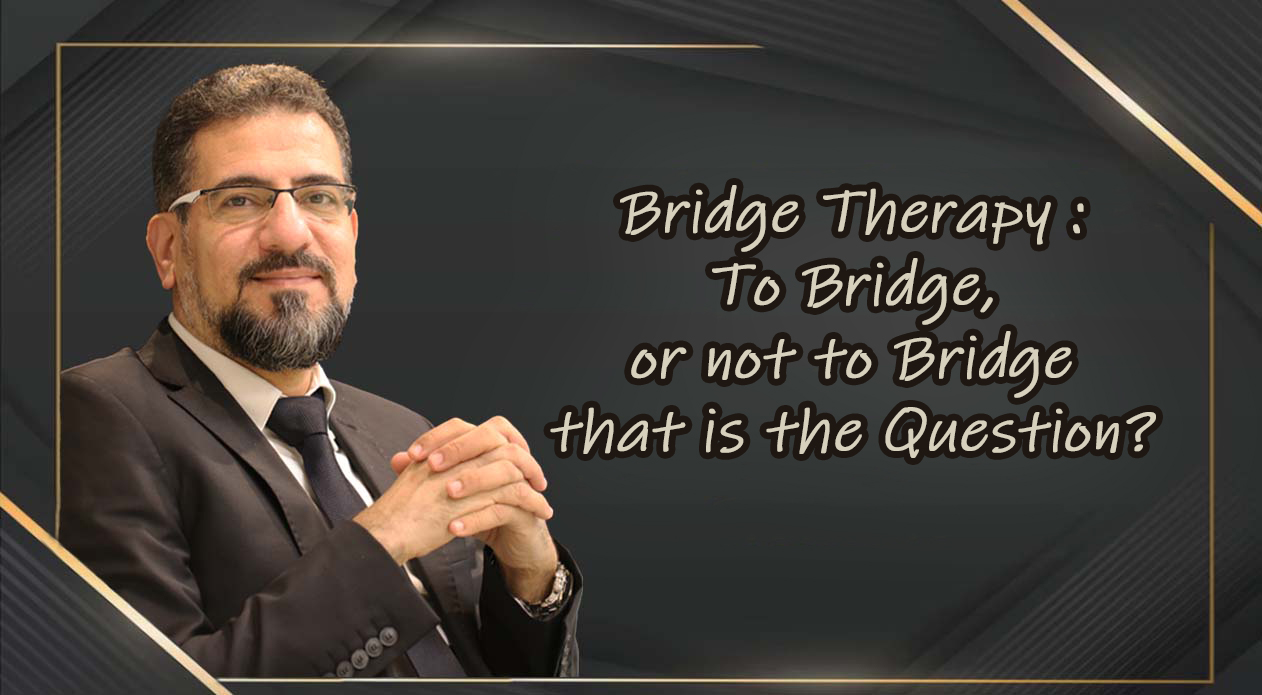Prof. Ayman Hegab is a Professor of Oral & Maxillofacial Surgery, Faculty of Dental Medicine. Al-Azhar University. Cairo. Egypt.
Patients undergoing oral anticoagulation treatment with vitamin K antagonist (VKA) therapy are at a high risk of bleeding when undergoing an oral surgical procedure. Bridging therapy with parenteral heparin, aims to protect these patients against thromboembolism during temporary periprocedural interruption of VKA therapy. Whether or not to interrupt VKA therapy and initiate bridging therapy is a difficult decision that is based upon both the patient’s and the procedure’s risks. The management of anticoagulation in patients undergoing surgical procedures is challenging because Interruption of anticoagulation temporarily increases thromboembolic risk and potentially fatal, while, continuing anticoagulation increases the risk of bleeding associated with surgical procedures; both of these outcomes adversely affect mortality.
The activity of warfarin is expressed using the International Normalized Ratio (INR). If patients on warfarin who require dental surgery have an INR of below 4.0, they can usually receive their dental treatment in primary care without needing to stop their warfarin or adjust their dose. The risk of thromboembolism after temporary withdrawal of warfarin therapy outweighs the risk of oral bleeding following dental surgery. Dentists should still be cautious before they remove teeth where the INR exceeds 3.A balance between reducing the risk of thromboembolism and preventing excessive bleeding is the keystone of successful management of such patients.
Estimate thromboembolic risk
A higher thromboembolic risk increases the importance of minimizing the interval without anticoagulation. Estimation of thromboembolic risk for patients with atrial fibrillation based on age and comorbidities. For those with a recent deep vein thrombosis or pulmonary embolism.And estimation of the risk based on the interval since diagnosis. If thromboembolic risk is transiently increased (eg, recent stroke, recent pulmonary embolism), its prefer to delay surgery until the risk returns to baseline, if possible.
Patients can be stratified into the following groups for thromboembolic risk:
High risk
mechanical mitral valve, ball-cage valve, venous thrombosis <3 months ago, hypercoagulable state, atrial fibrillation (AF) with a history of stroke, acute myocardial infarction<3 months ago or recent stroke (<1 month ago).
Intermediate risk
Bileaflet aortic valve with other risk factors for stroke, chronic AF, venous thromboembolism <6 months ago.
Low risk
AF without stroke, cardiomyopathy without AF, venous thrombosis >6 months ago, Bileaflet aortic valve with no other risk factors for stroke.
Estimate bleeding risk
A higher bleeding risk confers a greater need for perioperative hemostasis, and hence a longer period of anticoagulant interruption. Bleeding risk is dominated by the type and urgency of surgery. To have a balance we should consider a direct correlation relationship between the INR and the bleeding risk. If the bleeding risk increased, the INR should be decreased.
Bleeding risk can be categorized into three types:
Low bleeding risk,
supra-gingival scaling, simple restoration and local infiltration anesthetic injection (continue anticoagulant – INR < 4)
Moderate bleeding risk,
sub-gingival scaling, sub-gingival restoration, simple extraction, nerve block injection (consider modification of the anticoagulants-INR = 2-3)
High bleeding risk
complicated extraction, impaction, Apicectomy, bone surgery (bridge therapy)
Stopping warfarin increases the risk of thromboembolic events; the risk of thromboembolism after withdrawal of warfarin therapy outweighs the risk of oral bleeding. Moreover, Stopping warfarin is no guarantee that the risk of postoperative bleeding.
Bleeding can be further reduced with the use of local haemostatic measures like suturing, oxidized cellulose (Surgicel) or collagen sponges, pressuregauzes saturated with tranexamic acid for 2-3 hours. Avoid rinsing the mouth for 24 hours. Not to suck or disturb the socket with the tongue or any foreign object, avoid hot liquids and hard foods for the rest of the day.
Patients taking warfarin should not be prescribed non-selective NSAIDs (including ibuprofen, aspirin and diclofenac) and COX-2 inhibitors as analgesia following dental surgerybecause they irritate the stomach lining, which can result in gastrointestinal bleeding. Generally paracetamol is considered the safest simple analgesic for patients taking warfarin and it may be taken in normal doses if pain control is needed and no contraindication exists. Erythromycin and other macrolide antibiotics (for example, azithromycin) can interact with warfarin unpredictably and only in certain individuals with possibilities of increased postoperative bleeding. There are anecdotal reports that amoxicillin interacts with warfarin causing increased INR and/or bleeding but documented cases of an interaction are relatively rare considering how frequently the drug is used. Patients taking warfarin requiring a course of amoxicillin should be advised to be observant for any signs of increased bleeding. While; Metronidazole interacts with warfarin and should be avoided if possible. If it cannot be avoided, the warfarin dose may need to be reduced by a third to a half, and re-adjusted again when the antibiotic is discontinued.
Bridging therapy:
Discontinue warfarin 5 days prior tosurgery. Patients should be admitted to hospital and started on IVlow molecular weight heparin in therapeutic doses. Continuous monitoring of the patient INR within the therapeutic level till the preoperative day. IV heparin should be discontinued 4 to 6 hours prior to surgery. After surgery, all the local haemostatic measures should be firmly implemented. Post-operatively, warfarin should be resumed when the patient is able to take medications by mouth. Resume IV heparin when hemostasis secured and not earlier than 12 hours after surgery. In the 5 postoperative day, stop low molecular weight heparin when INR therapeutic by the action of warfarin.
Points to remember:
: Balance between Thromboembolic risk and bleeding risk is the keystone of management of such patients. Bleeding complications, while inconvenient, do not carry the same risks as thromboembolic complications. The INR must be measured prior to dental procedures, ideally within 24 hours before the procedure. Patients whose INR results are within the acceptable therapeutic range are more at risk of permanent disability or death if they have their warfarin stopped prior to a surgical procedure than if they continue it. Patients with a target INR between 3.0 and 4.0 are at a high risk of thromboembolism and stopping or reducing their INR exposes them to an increased risk of life threatening thrombosis. Liver impairment and/or alcoholism, renal failure, thrombocytopenia are medical problems may affect coagulation and clotting and complicate the case. Consider the timing of the dental procedure. It is recommended treatment takes place in the morning at the beginning of the week when re-bleeding problems can be managed during the working day and working week.Use a local anesthetic containing a vasoconstrictor. Give local anesthetics by infiltration or intraligamentary injection wherever practical. Avoid nerve blocks where possible. However, if there is no alternative administer cautiously using an aspirating syringe.Gently pack the socket with an absorbable haemostatic dressing. Carefully suture the socket.Paracetamol is the analgesic of choice.




 Ask Prof. Hegab
Ask Prof. Hegab +201004401598
+201004401598

